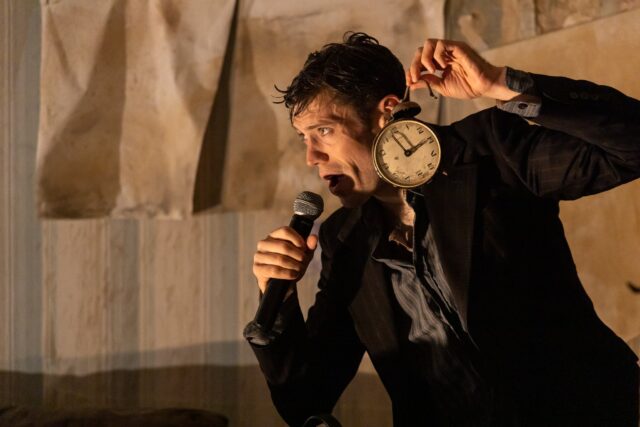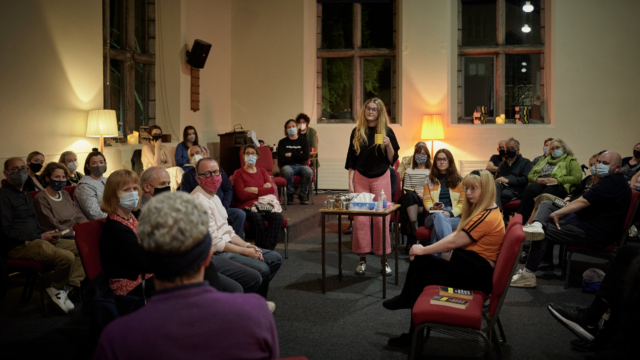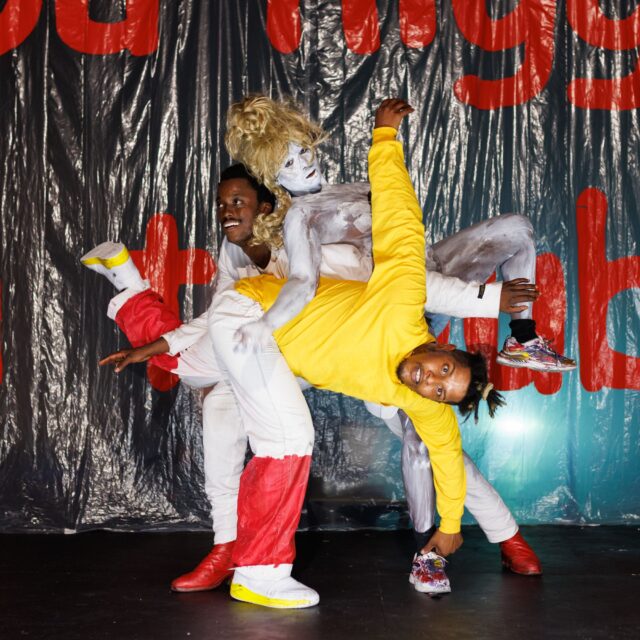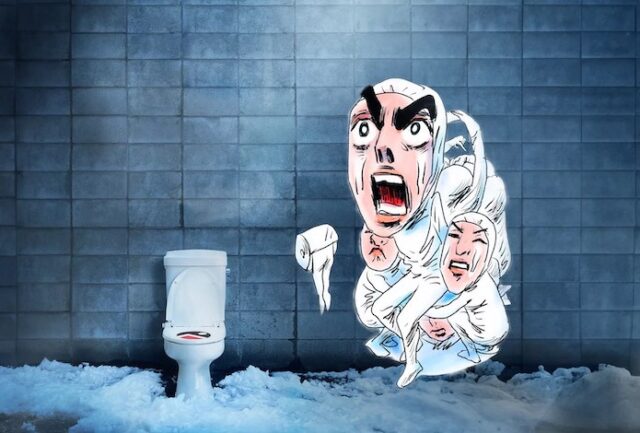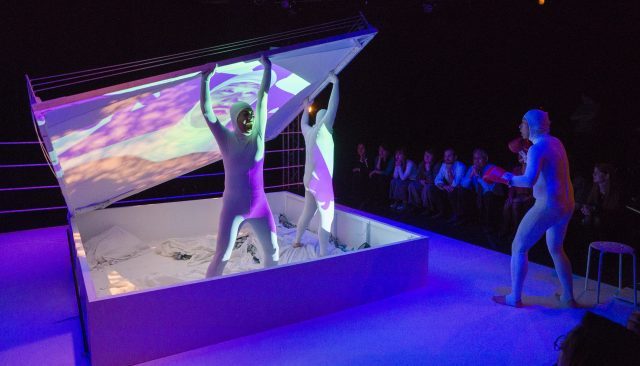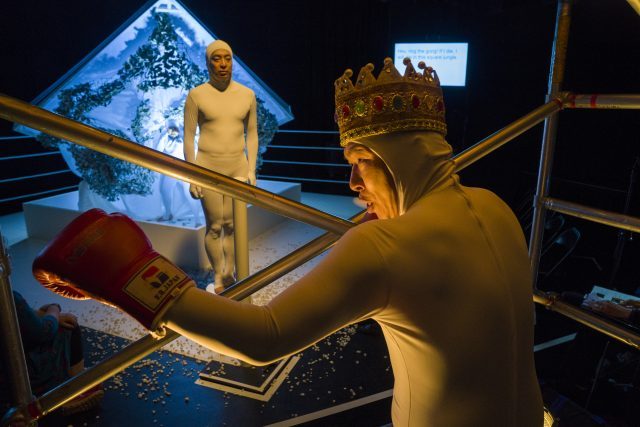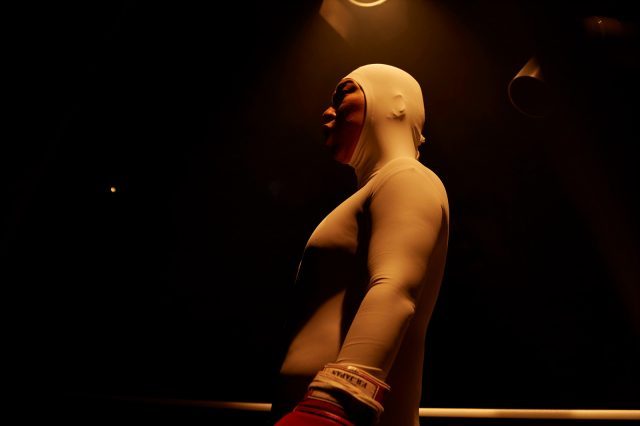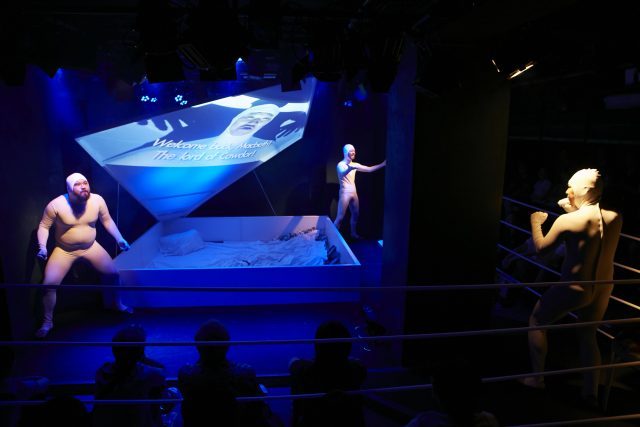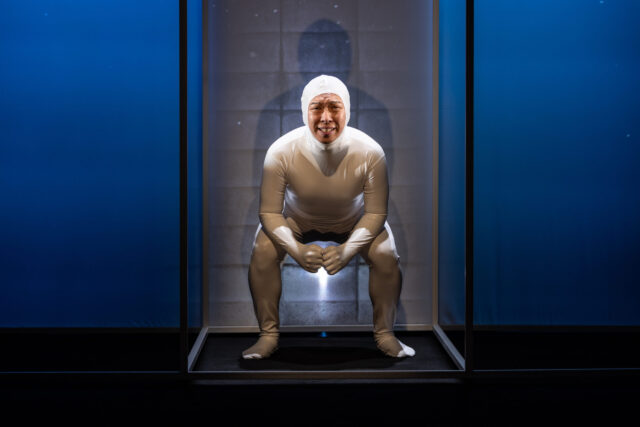
Hamlet (Takuro Takasaki) is in desperate need of a bowel movement in HAMLET | TOILET (photo © Maria Baranova)
HAMLET | TOILET
Japan Society
333 East 47th St. at First Ave.
January 10-13, $35
japansociety.org
To go, or not to go? That is the multilayered question asked in Yu Murai and Kaimaku Pennant Race’s absurdist, scatological HAMLET | TOILET, continuing at Japan Society through January 13 as part of the Under the Radar festival.
As you enter Japan Society, you are greeted by a different kind of step and repeat; instead of posing in front of a show logo, you can snap a selfie with a glitteringly white Japanese Toto washlet on a red platform, a fancy toilet with such special features as a heated seat and a bidet. It sets the mood for what is to follow, ninety minutes of controlled chaos involving more flatulence than the beans scene in Mel Brooks’s Blazing Saddles.
Murai has previously reimagined works by William Shakespeare in Romeo and Toilet and Ashita no Ma-Joe: Rocky Macbeth, wildly unpredictable tales that incorporate dance, music, strange props, and bizarre costumes. HAMLET | TOILET sits comfortably within that oeuvre. The production takes place in and around a three-stall installation, an open cube with a back wall and no doors. The three actors, Takuro Takasaki, G. K. Masayuki, and Yuki Matsuo, are dressed in unflattering white body-hugging latex suits reminiscent of the spermatozoa in Woody Allen’s Everything You Always Wanted to Know About Sex* (*But Were Afraid to Ask).
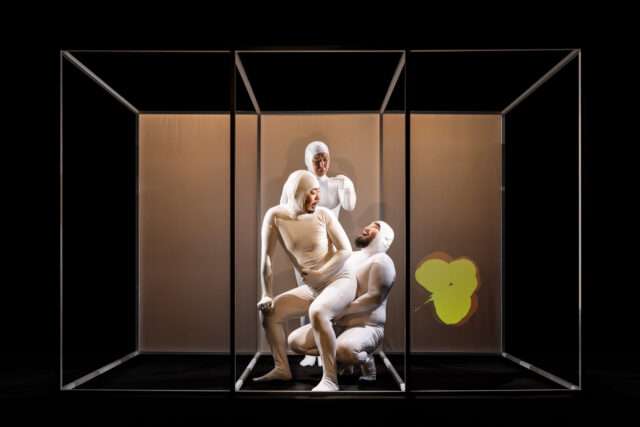
Plenty of flatulence is on the menu in unique adaptation of Hamlet at Japan Society (photo © Maria Baranova)
The essence of the Bard’s tragedy is in there, somewhere: Hamlet’s (Takasaki) uncle, Claudius (Masayuki), has killed Hamlet’s father, married his mother, and become king. Hamlet is in love with Ophelia (Masayuki), whose brother, expert fencer Laertes (Matsuo), is not a Hamlet fan. Hamlet’s besties, Horatio (Masayuki) and Marcellus (Matsuo), have encountered the ghost of their friend’s father, who tells his son that his murder must be avenged. To do so, Hamlet has to face his conscience, which is not lodged in his brain or heart but in his painful belly — the load he is carrying is an intensifying bowel movement that his multidimensional constipation will not allow him to release.
For much of the show, the actors are in the middle stall, trying to take dumps, either squatting by themselves or sitting on a cushiony human bowl formed by the other two actors. They gleefully pass gas that is projected in colorful animation by Takashi Kawasaki, accompanied by the appropriate sounds. The characters discuss aspects of making number two in ways that no play or novel that I know of ever has; no bathroom subject or feces joke is off limits, regardless of how silly or lowbrow. Nobody can find relief, not even from Ophelia’s headdress, which consists of dozens of rolls of toilet paper.
Amid deep dives into the shape, consistency, aroma, and chocolatey nature of human waste, Murai also delves into cowardice, sanity, suffering, and revenge. The dialogue is similarly mixed; Hamlet veterans will appreciate such real Shakespearean lines as “That adulterate beast won to his shameful lust . . . my queen,” “Never make known what you have seen [and heard] tonight,” “[I am going to] put an antic disposition on,” and “I should have fatted all the region kites / With this slave’s offal: bloody, bawdy villain!”
Purists might grimace at the more coarse language, such as “Something must be born that will trace a single line / like a magnificent line of feces / straight through all of this wonderful society,” “Please, just this once / couldn’t it be soft and gently flow like water,” “You must cleanly and completely defecate me!” and “In a world that is moved by the strict laws of almighty God / that which should not have moved has passed / That’s why my movement will not pass!” Even the subtitles themselves are in on the fun, changing the spelling and capitalization of nec-ASS-arily and BUTT (instead of but).
The three actors occasionally break out into song and dance; the music is by DJ and hip-hop producer Tsutchie from Shakkazombie, with hilarious choreography by Shinnosuke Motoyama. There’s far too much repetition, as numerous jokes spew out like the preparation for a colonoscopy, and in one scene the play makes fun of that itself as repeated statements fill up the subtitles monitor in ever-smaller type. But just when you think the production is merely a fart-fantasy concocted by Eric Cartman or Beavis and Butt-Head, Murai slips in something ridiculously clever so you won’t lose your appetite; it’s not merely Shakespeare as bathroom reading, although that’s in there too. Murai is not claiming that Shakespeare, or theater in general, is full of shit, but it might be in need of a thorough cleansing.
Which brings us back to the original question: To go, or not to go? HAMLET | TOILET is certainly not for everyone; some gags were met with laughter and applause, while others received random chuckles or guffaws — or silence. If you do get a ticket — the January 12 performance will be followed by an artist Q&A — be sure to use the facilities, which have several washlets, in addition to doors to ASSure your privacy.
[Mark Rifkin is a Brooklyn-born, Manhattan-based writer and editor; you can follow him on Substack here.]
